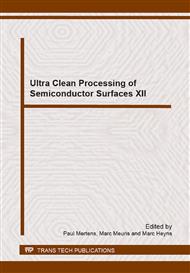p.197
p.201
p.205
p.209
p.213
p.217
p.221
p.225
p.233
Industrial Challenges of TiN Hard Mask Wet Removal Process for 14nm Technology Node
Abstract:
TiN Hard Mask (TiN-HM) integration scheme has been widely used for BEOL patterning in order to avoid ultra low-k (ULK) damage during plasma-ash process [1]. As the technology node advances, new integration schemes have to be used for the patterning of features below 80 nm pitch with 193 nm immersion lithography. In particular, thicker TiN-HM is necessary in order to ensure Self-Aligned-Via (SAV) integration which resolves via-metal short yield and TDDB issues caused by Litho-Etch-Litho-Etch (LELE) misalignment [2, 3]. The Cu filling process is significantly more difficult if the thick TiN is not removed because of the high aspect ratio of the structures. Moreover, with the use of TiN hard mask, a time-dependent crystal growth (TiCOF) residue may forms between line etch and metal deposition [4, 5], also hindering copper filling. Post-Etch-Treatment after line etching is one solution to the problem but N2 plasma is not efficient enough to suppress the residue completely [6], and the CH4 treatment proposed in [5] may be difficult to implement for 14 nm node, thus an efficient wet strip and clean provides a better solution.
Info:
Periodical:
Pages:
213-216
Citation:
Online since:
September 2014
Keywords:
Price:
Сopyright:
© 2015 Trans Tech Publications Ltd. All Rights Reserved
Share:
Citation:


